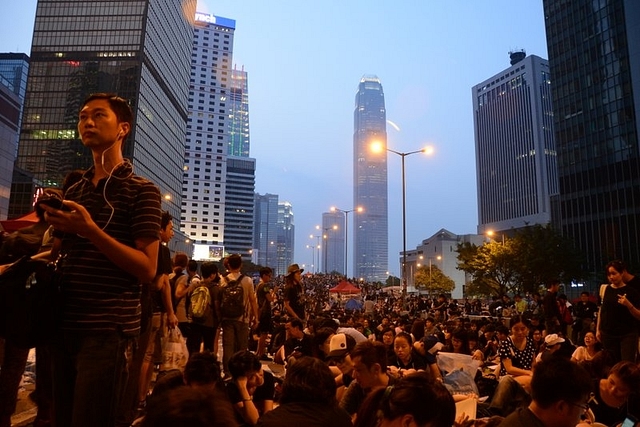
Freedom For The Fragrant Harbour
Pictures from Hong Kong’s Umbrella Revolution, the biggest people’s movement in China since Tiananmen Square.
It was a week like never before. For the first time since 1997, the year Hong Kong—or the Fragrant Harbour—was returned to China by Britain under the Sino-British Joint Declaration, tens of thousands of students paralyzed Asia’s most dynamic city for an entire week.
In fact, the Umbrella Revolution, the name which the uprising came to be known by, was the biggest pro-democracy political movement in China since the 1989 demonstrations in Tiananmen Square.
On August 31, the Standing Committee of the National People’s Congress (NPCSC) announced electoral reforms, under which, instead of allowing civil nominations, a nomination committee would elect up to three electoral candidates for the public to vote on. After the election, the Chief Executive-elect—Hong Kong’s top leader—would have to be formally appointed by the central government before officially taking the post.
By September 22, thousands of students were out on the streets. They blocked the government headquarters, shut down the two arterial roads in northern Hong Kong. They faced pepper spray and tear gas but stayed put. The state-run Chinese media has warned of “deaths and injuries and other grave consequences” if the protests continue, and has complained repeatedly of foreign interference, On October 6, the Chief Executive agreed to talks on political reforms.
Now, preliminary talks have begun, and the student-led movement has strengthened the hand of Hong Kong’s democratic lawmakers. “The power shown by the people in this civil protest is the power of the powerless,” Albert Ho, the former head of the Democratic Party and a candidate for chief executive in 2012, told The New York Times. “We have been able at least to create sufficient pressure on the government for the commencement of a dialogue. They know that the theme of discussion is political reform. Previously, everybody treated this as a closed chapter.”
Veteran journalist and longtime Hong Kong resident Vijay Verghese documented the week of demonstrations in pictures which reveal the very human soul of the city of steel and concrete.
All pictures are copyright of Vijay Verghese
1. A row of brightly coloured umbrellas, that have come to symbolise the Hong Kong protests, along Connaught Road, Monday 6 October. The crowds have dwindled, if not the enthusiasm.
2. Looking up past umbrellas from a pedestrian bridge at Admiralty—the centre of the student protests—on Sunday 5 October. The iconic IFC tower in Central District is to the right.
3. Friday 3 October night was perhaps the peak of the protest as students and well wishers crowded the blocked roads around Admiralty taking in the festive atmosphere.
4. A tense standoff in Causeway Bay, the shopping heartland, as police separate ‘Occupy’ protesters and ant-protests groups.
5. Shopping epicentre Causeway Bay grinds to halt Friday 3 October night as demonstrators clear the roads of traffic and would-be shoppers. Shops remain open for business though but complain of waning sales. Mainland China groups are still coming in to Hong Kong on shopping excursions though several itineraries have been cancelled.
6. Mongkok in the heart of Kowloon is where the triads (criminal gangs) were allegedly turned loose on students to help remove barricades. It served instead to bring public opinion squarely behind the peaceful students. On occasion, irate older residents of this neighbourhood castigated the kids for interrupting business.
7. Admiralty has a last hurrah Sunday 5 October night before the weekend support dissipates in anticipation of a trying week ahead.
8. Cameramen on vigil with the students who feared police intervention early morning Monday 6 am. It didn’t materialise and students slowly began trickling back to class as the government held out the olive branch of negotiations.
9. A poignant sticker wall with notes from well wishers, parents, friends, tourists and just about everyone who has been through. A visitor pauses to read a message, some from kids as young as five.
10. Gloucester Road, normally a thrumming artery of commerce is becalmed Monday 6 October as roads remain closed and vehicles are diverted onto side streets causing citywide gridlock, which drivers are taking in their stride. There’s little honking to be heard.